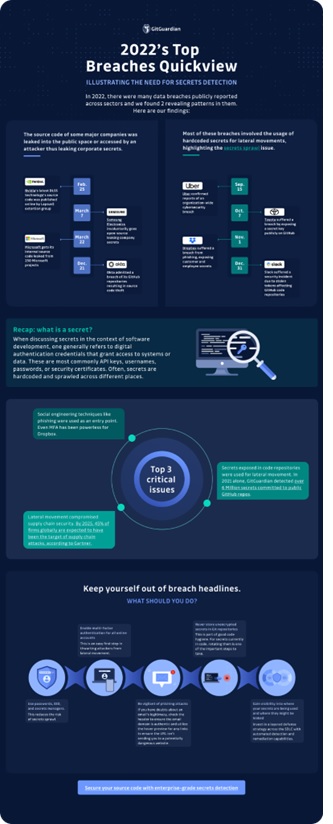How to Bake Security into your CI/CD Pipeline
According to IBM Security’s “The Cost of a Data Breach Report”, the global cost of data breaches in 2022 increased by 2.6% compared to previous year, reaching $4.35 million. The source code of major companies like Nvidia, Microsoft, Uber, Slack, Toyota was leaked, often caused by usage of hardcoded secrets (you can see more details in the infographics below).
In those cases, lateral movements were compromising software supply chain security. In their report Gartner claims about 45% of companies should expect to become targets of supply chain attacks by 2025.
One of the ways to keep yourself out of breach headlines is by securing your CI/CD pipeline. In this article, we discuss the importance of securing your CI/CD pipeline and some of the best practices to be proactive.
The risks of CI/CD
Continuous integration and continuous delivery (CI/CD) pipeline is an essential part of software development and deployment. It is also referred to as the DevOps pipeline, and it helps developers quickly build, test, and deploy new applications and services at scale.
While reducing the chances of human errors, automating such processes may lead to additional cyber threats. Unfortunately, many organizations overlook security considerations when using CI/CD pipelines, leaving them vulnerable to threats.
Identity Management and Access Control in CI/CD
The first step in securing a CI/CD pipeline is to ensure that only authorized users have access to it. To do this, you should implement access controls to restrict access privileges. You can use single sign-on (SSO) or role-based access control (RBAC) to manage user accounts.
Additionally to human access, you should authenticate any third-party services that interact with the CI/CD pipeline as well as eliminate unused assets immediately after use. This helps prevent unauthorized access or and doesn’t let malicious actors from infiltrating your system.
Prevent hardcoded secrets exposure in your CI/CD
Another important aspect of securing a CI/CD pipeline is storing secrets securely. You should always store your secrets using a built-in solution provided by your provider, instead of hardcoding them into the codebase, since this makes them much easier to access by malicious actors. Furthermore, using a key manager such as Hashicorp Vault for secret storage allows for better security measures such as automated secrets rotation. By controlling the lifetime of each password you reduce the risk of unauthorized access or data leakage from old credentials.
Active Monitoring of Systems and Services
Finally, it's important to actively monitor your systems and services for suspicious activities or unexpected changes in order to detect possible threats early on before any lateral movement occurs. You can set up honeytokens to receive alerts that notify you if any unauthorized changes occur in the system or if any suspicious activity takes place. Use honeytokens as a part of automated environment builds with a tool like Terraform. This way you can take steps to mitigate the threat before it becomes too late.
Conclusion
Securing a CI/CD pipeline is essential for protecting the integrity of your applications and services from potential threats or attacks.
Here are the best practices to secure your CI/CD pipeline:
- implement identity management processes such as SSO or RBAC;
- enable authentication protocols for third-party services;
- use secure secret storage solutions like Hashicorp Vault;
- review the Top 10 CI/CD Security Risks by OWASP
- detect possible threats using honeytokens early on before they become too severe so that appropriate countermeasures can be taken swiftly and efficiently when needed.
You can greatly reduce the risk of attack on your systems while still allowing developers to quickly build, test, and deploy new applications at scale with confidence that their work is secure from potential threats.
ThreatIntel and AppSec professionals should take these steps seriously if they want their organizations to remain secure against malicious actors attempting to breach their systems by exploiting vulnerabilities within their CI/CD pipelines.


